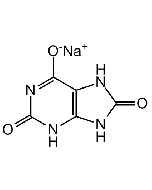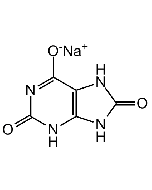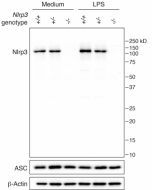Cookie Policy: This site uses cookies to improve your experience. You can find out more about our use of cookies in our Privacy Policy. By continuing to browse this site you agree to our use of cookies.
AdipoGen Life Sciences
N-Acetyl-D-glucosamine
As low as
15
CHF
CHF 15.00
In stock
Only %1 left
AG-CN2-0489-M250250 mgCHF 15.00
AG-CN2-0489-G0011 gCHF 25.00
AG-CN2-0489-G0055 gCHF 65.00

| Product Details | |
|---|---|
| Synonyms | D-GlcNAc; GlcNAc; NAG; 2-(Acetylamino)-2-deoxy-D-glucose |
| Product Type | Chemical |
| Properties | |
| Formula |
C8H15NO6 |
| MW | 221.2 |
| CAS | 7512-17-6 |
| RTECS | LZ6651000 |
| Source/Host Chemicals | Prepared by using chitin as a substrate. |
| Purity Chemicals | ≥95% (NMR) |
| Appearance | White to off-white solid. |
| Solubility | Soluble in DMSO (10mg/ml) or water. |
| InChi Key | OVRNDRQMDRJTHS-KEWYIRBNSA-N |
| Smiles | OC1[C@H](NC(C)=O)[C@@H](O)[C@@H](O)[C@@H](CO)O1 |
| Shipping and Handling | |
| Shipping | AMBIENT |
| Short Term Storage | +4°C |
| Long Term Storage | -20°C |
| Handling Advice |
Keep cool and dry. Protect from moisture and oxygen. |
| Use/Stability | Stable for at least 2 years after receipt when stored at -20°C. |
| Documents | |
| MSDS |
 Download PDF Download PDF |
| Product Specification Sheet | |
| Datasheet |
 Download PDF Download PDF |
Description
- N-Acetyl-D-glucosamine (D-GlcNAc) is a non-toxic derivatized glucose monosaccharide found in polymers (Peptidoglycan; PGN) of bacterial cell walls, chitin (e.g. fungi, invertebrates, crustaceans), hyaluronic acids and various glycans. It is also synthesized in the glycosylation pathway as uridine diphosphate (UDP-GlcNAc), which can then be released following degradation of glycosylated proteins.
- Atypical microbial danger signal that acts as a new activator of NLRP3 inflammasome by dissociating the enzyme hexokinase from the mitochondria. D-GlcNAc inhibits purified hexokinase, which is also involved in the glucose metabolism and obesity in mM range. For hexokinase dissociation from the mitochondria much higher concentrations are needed.
- Acceptor substrate for galactosyltransferases. Inhibits the lectin WGA and is used to identify, differentiate and characterize N-acetyl-β-D-hexosaminidase(s).
- Used in the treatment of osteoarthritis and inflammatory bowel disease (IBD), including ulcerative colitis and Crohn's disease. Significantly enhances the prevention of joint damage and inhibits elastase activity and superoxide release from human polymorphonuclear leukocytes. Acts as a cytoprotective agent restoring the integrity and normal function of mucous membrane in humans.
- D-GlcNAc enhances the proliferation and collagen expression of fibroblasts, reduces hyperpigmentation and is therefore considered a valuable ingredient in cosmetics for improving skin wrinkles and color.
- Important substrate for the production of sialic acids.
- Used in multiple other applications in drug development and food supplement, based on a newly described bio-wave model.
Product References
- Inhibition of elastase enzyme release from human polymorphonuclear leukocytes by acetylgalactosamine and N-acetylglucosamine: M. Kamel, et al.; Clin. Exp. Rheumatol. 9, 17 (1991)
- N-Periodic phenomena in proteus mirabilis swarm colony development: O. Rauprich, et al.; J. Bacteriol. 178, 6525 (1996)
- A pilot study of N-acetyl glucosamine, a nutritional substrate for glycosaminoglycan synthesis, in paediatric chronic inflammatory bowel disease: S. Salvatore, et al.; Aliment. Pharmacol. Ther. 14, 1567 (2000)
- Enhanced healing of cartilaginous injuries by N-Acetyl-D-glucosamine and glucuronic acid: Y. Tamai, et al.; Carbohydr. Polym. 54, 251 (2003)
- Reduction in the appearance of facial hyperpigmentation by topical N-acetyl glucosamine: D. Bissett, et al.; J. Cosmet. Dermatol. 6, 20 (2007)
- Production of N-acetyl-neuraminic acid by recombinant whole cells expressing Anabaena sp. CH1 N-acetyl-D-glucosamine 2-epimerase and Escherichia coli N-acetyl-neuraminic acid lyase: Y.C. Lee, et al.; J. Biotechnol. 129, 453 (2007)
- Effect of different concentrations of collagen, Ceramides, N-acetyl glucosamine, or their mixture on enhancing the proliferation of keratinocytes, fibroblasts and the secretion of collagen and/or the expression of mRNA of type I collagen: R.H. Chen, et al.; J. Food Drug Anal. 16, 66 (2008)
- N-acetylglucosamine: production and applications: J.K. Chen, et al.; Mar. Drugs. 8, 2493 (2010) (Review)
- Hexokinase is an innate immune receptor for the detection of bacterial peptidoglycan: A.J. Wolf, et al.; Cell 166, 624 (2016)
- When Hexokinase Gets that NAG-ing Feeling: D. O'Sullivan, et al.; Cell Metab. 24, 198 (2016)
- NAGging Hexokinase PEPs up NLRP3: H. Hampton, et al.; Cell Host Microbe 20, 130 (2016)








